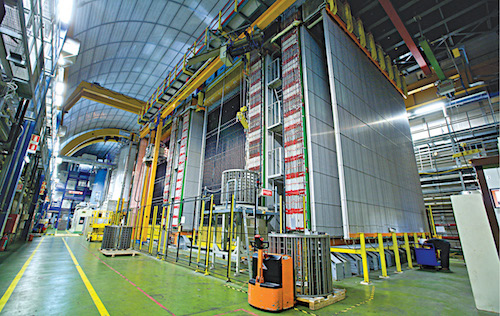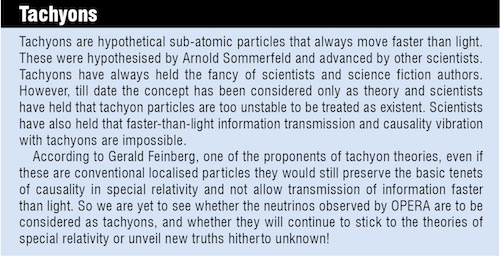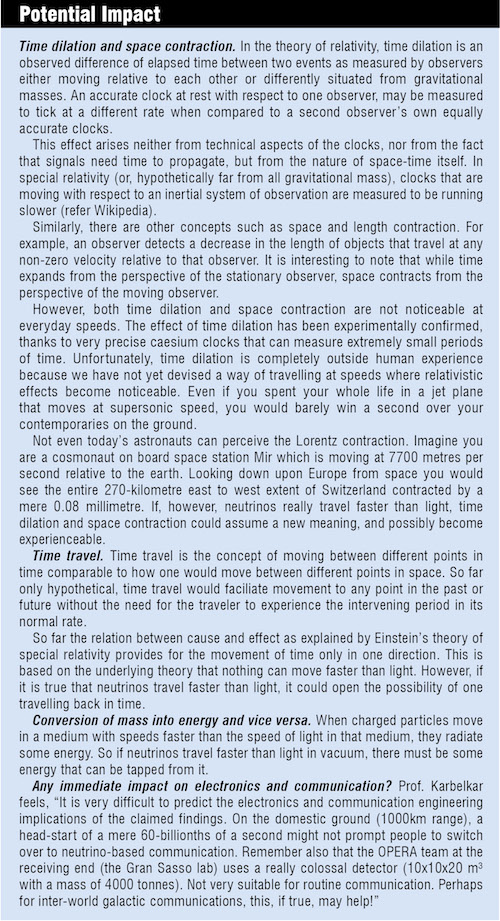It was indeed haunting to see some of the world’s greatest scientists waving their hands in frenzy and saying “If this is true, we would have to tear up all our textbooks and rewrite them.” There was a lot of excitement too as the new finding meant lots and lots of new research.
Would you believe that a shy little neutrino is at the heart of all this discussion? “Neutrino is an anti-social particle which doesn’t like to talk to the world in general. We are crossed by millions of neutrinos every second, but we don’t feel them,” said Prof. Joao Magueijo of the Imperial College of London, when interviewed for a BBC documentary. The show’s anchor put the neutrino more in perspective (or out of it) by saying, “If the atom is the solar system, the neutrino is a golf ball.”

Neutrino is tiny. It is almost weightless, with no electric charge and capable of travelling through solid matter without reacting with anything. In short, it is inconspicuous. However, this miniscule sub-atomic particle recently created a furore in the physics community as some scientists in Northern Italy observed neutrinos to have travelled faster than light.
If you browse through any physics, computer science, optics, electrical, electronics or communication engineering handbook, or any other encyclopaedia, you will realise that modern science is based on Einstein’s theory that the speed of light in vacuum is absolute, and nothing with mass can ever travel faster than light. Whether you recall it by the name of special relativity or the formula E=mc2, we owe it to Einstein for having unravelled the mysteries of space, light, speed, time and many of the other concepts we take for granted today.
However, an unexpected event has now cast a slight shade of doubt upon Einstein’s theories. It is too early to dispute the father of modern physics yet but here is all the information you need to understand this affair as it unfolds in newspapers and journals in the coming months.
One fine day, in the heart of a large mountain…
The Gran Sasso National Laboratory (LNGS) is situated in a national park in Northern Italy, deep within a large mountain. It has a 1400-metre rock cover above it making the lab almost free of cosmic ray flux. The neutron flux is also thousand times less than on the surface, thanks to the very little uranium and thorium content of the dolomite rocks of the mountain. LNGS is the largest underground laboratory in the world for experiments in particle physics, particle astrophysics and nuclear astrophysics with over 750 scientists working on various experiments.
The team that grabbed our attention with its findings is working on the Oscillation Project with Emulsion-tRacking Apparatus (OPERA). The OPERA experiment involves the study of neutrino oscillations. A high-intensity and high-energy beam of muon-neutrinos is produced 730 km away at CERN in Geneva and directed towards the Gran Sasso laboratory. A wall comprising 150,000 bricks of photographic emulsion films interleaved with lead plates (each weighing more than 8 kg) and other complementary apparatus, like trackers and oscillometers, detects the appearance of tau-neutrinos from the oscillation of muon-neutrinos during their 3-millisecond (ms) travel from Geneva to Gran Sasso.
The OPERA apparatus has been collecting data since 2008, but in March 2011 the researchers noticed something strange. The neutrinos fired from Geneva apparently arrived at Gran Sasso around 60-billionth of a second earlier than light in vacuum!
A tortoise raced the hare
Why should we bother about a speed of this magnitude? Simply because it goes against the founding principle of modern physics that “nothing can travel faster than light in vacuum.” If the findings are right, it would wreak havoc on the principle of cause and effect. It would make it possible to send information back in time, blurring the line between past and present. Time travel, space contraction, the conversion of mass into energy and a lot of other things that were once the realm of science fiction would become reality!

The scientists at Gran Sasso conducted more experiments and in September 2011, on achieving similar results repeatedly, they made their findings open. They requested other laboratories to analyse the results and share their opinions, as well as try and replicate the experiments. At the same time, they spotted various areas where their experiment might have failed, with the intention of ruling out all possible weaknesses. In November, they repeated the experiment with improved conditions—in the process ruling out at least one of the potential faults in the first experiment. The neutrino won the race again.
Improved experiment
In the September experiment, the pulses of neutrinos sent by CERN were relatively long—around 10 ms each. So measuring the exact arrival time of the particles could have large errors. In November, the experiment was repeated with beams that were thousands of times shorter—just 3 ns. There were large gaps of 524 ns between these. So OPERA could measure the arrival time with greater accuracy.
With such short pulses, one does not have to worry about the shape, duration, etc of the beams. It is just a ‘click,’ and one has to note when it happened without worrying about when the beam started or ended. Being more accurate, a shorter number of readings (20 instead of 15,000 made in September) were enough to replicate the earlier experiment.
While the OPERA team has been making its findings public, it is still reluctant to dispute Einstein’s theory. They are merely requesting others to pay attention to this phenomenon and validate the experiments independently, while at the same time planning further experiments themselves. For one thing, they are planning to repeat the experiments using muon detectors with improved clock synchronisation.
The team is also considering the use of optical fibres instead of geographical positioning system (GPS) used currently. Einstein’s theory of relativity says that the clock ticks at different rates depending on the gravitational force at a place—this could cause a difference in timing. The use of optical fibres instead of GPS could overcome this discrepancy also.
Mixed reactions
As with any ‘big’ announcement, OPERA’s revelation has also been met with mixed reactions. While on the one hand, there are scientists raring to create a ‘new’ physics, there are also those who are dismissing the findings as mere humbug. Faulty experiments, say some, while others blame the different gravitational conditions at CERN and Gran Sasso. Quite understandably, it is not easy for the world of science to accept a challenge to the very foundation of modern physics.
In fact, another group of scientists working at Gran Sasso has itself contradicted the OPERA findings. The ICARUS Collaboration, another team at Gran Sasso, also captured some of CERN’s neutrinos. Their goal was to measure the energy and not the journey time. If the neutrinos travelled faster than light, these would have emitted some radiation throughout the journey, losing energy in the bargain. However, the energy remained the same from start to end—so OPERA’s claim is not feasible, according to the ICARUS Collaboration.

Prof. Dr Subhash Karbelkar, head of the department of physics, BITS-Pilani, explains, “If an object travels faster than the speed of the appropriate waves, it leaves behind a trail of disturbances, which naturally costs it some energy. A familiar example of this phenomenon is the sonic boom behind supersonic (faster-than-sound) planes or the conical wake that ducks leave on the pond’s surface. When charge particles move in a medium with speeds faster than the speed of light in that medium, a kind of radiation called the Cerenkov radiation is emitted by them. It has been predicted by Cohen and Glashow (Nobel laureate) that in a similar manner, neutrinos moving faster than light should emit some such radiation and in the process lose out energy in a specified manner. The ICARUS team has reported that they have seen no such effect in the energy distribution of the neutrinos.”
He also points out another reason to doubt the ‘faster than light’ phenomenon. “When the famous supernova explosion happened in 1987, the light and neutrino bursts from it came more or less at the same time (with a few hours’ difference), whereas OPERA’s claim would imply that the neutrinos should have reached several years earlier. Considering the fact that the time taken for light is only estimated in the OPERA experiment we must be more patient and wait for a more rational explanation of the observation to surface. So it looks that there is no need to doubt the Einstein’s theory of relativity at this time.”
It is to be noted that OPERA’s and ICARUS’ efforts were experiments and not discoveries. The difference between the two is humongous. While even the smallest discovery might be accepted without doubt, no experiment would be absolutely acceptable unless verified by a third party. It is believed that some labs in the US and Japan have undertaken to verify this observation.
Prof. Karbeklar adds, “The relativity theory has been verified in so many ways that even if the new OPERA result is confirmed, it may not entirely scrap Einstein’s theory; just as Einstein’s theory didn’t overthrow the previous one entirely but only brought out its limits of validity. But as I have mentioned earlier, it is a bit too early to treat the OPERA result as firmly established.”
So we need to wait and see. No hurry to rewrite our textbooks!
The author is a technically-qualified freelance writer, editor and hands-on mom based in Chennai







